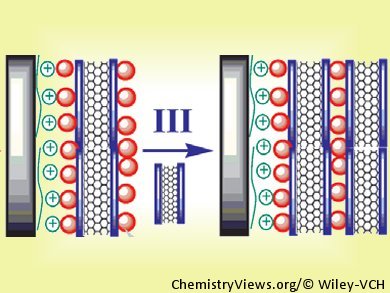Hydrazine is both a useful and toxic substance, thus its sensitive detection is highly desirable.
Yu Chen and co-workers, Nanjing Normal University, China, have used a layer-by-layer (LBL) self-assembly method to fabricate multilayers consisting of sulphydryl-functionalized multiwall carbon nanotubes (MWCNT) and gold nanoparticles (Au NPs). They have reported their use as electrochemical sensors for hydrazine detection (pictured).

The LBL self-assembly approach involved π–π stacking interactions to graft the sulphydryl groups onto the surface of the MWCNTs and exploited the strong Au–S bond interactions between the components to generate an advanced sensor with better performance compared to known sensors, e.g., detection limit of 2.0·10–7 M and linear range of 6.0·10–7 to 9.0·10–3 M.
Image: © Wiley-VCH
- Layer-By-Layer Self-Assembly of Sulphydryl-Functionalized Multiwalled Carbon Nanotubes and Phosphate-Functionalized Gold Nanoparticles: Detection of Hydrazine,
Fan Zhang, Lu Zhang, Junfei Xing, Yawen Tang, Yu Chen, Yiming Zhou, Tianhong Lu, Xinghua Xia,
ChemPlusChem 2012, 8.
DOI: 10.1002/cplu.201200137
This article is available for free as part of the ChemPlusChem free trial.
- Issue 8 of ChemPlusChem coincides with the 4th EuCheMS Chemistry Congress, organized by the European Association of Chemical and Molecular Sciences (EuCheMS) and the Czech Chemical Society, in Prague. The predecessor journal, Collection of Czechoslovak Chemical Communications, originated from here.
Issue 8 provides a first class cross section of papers by the three Chairmen and selected Board Members that highlight the high-impact multidisciplinary research published in ChemPlusChem.




